Supplementary Cementitious Materials Market Size 2025-2029
The supplementary cementitious materials market size is valued to increase USD 14.27 billion, at a CAGR of 8.8% from 2024 to 2029. Increase in building and construction activities will drive the supplementary cementitious materials market.
Major Market Trends & Insights
- APAC dominated the market and accounted for a 52% growth during the forecast period.
- By Type - Fly ash segment was valued at USD 11.66 billion in 2023
- By Application - Residential segment accounted for the largest market revenue share in 2023
Market Size & Forecast
- Market Opportunities: USD 101.15 billion
- Market Future Opportunities: USD 14271.20 billion
- CAGR from 2024 to 2029 : 8.8%
Market Summary
- The Supplementary Cementitious Materials (SCMs) market has experienced significant growth in recent years, driven by the increasing demand for sustainable and eco-friendly building solutions. One notable data point underscores this trend: the market value for SCMs is projected to reach USD 21.5 billion by 2025, reflecting a steady expansion. SCMs, such as fly ash, slag, and silica fume, are essential additives that enhance the performance and sustainability of cementitious materials. They offer numerous benefits, including improved workability, increased strength, and reduced carbon emissions. As a result, their use has gained traction in various sectors, including infrastructure, residential, and commercial construction.
- However, the high price of silica fume, a particularly effective SCM, poses a challenge to the market's growth. Despite this hurdle, innovations in production processes and alternative sources are being explored to make silica fume more affordable. Moreover, the increasing awareness of the environmental impact of the construction industry and the need for greener alternatives to traditional cement are expected to further fuel the market's expansion. In summary, the market is poised for continued growth, driven by the increasing demand for eco-friendly building solutions and the benefits offered by these materials. Despite the challenges, ongoing research and innovation are expected to address the high cost of certain SCMs and further solidify their role in the construction industry.
What will be the Size of the Supplementary Cementitious Materials Market during the forecast period?
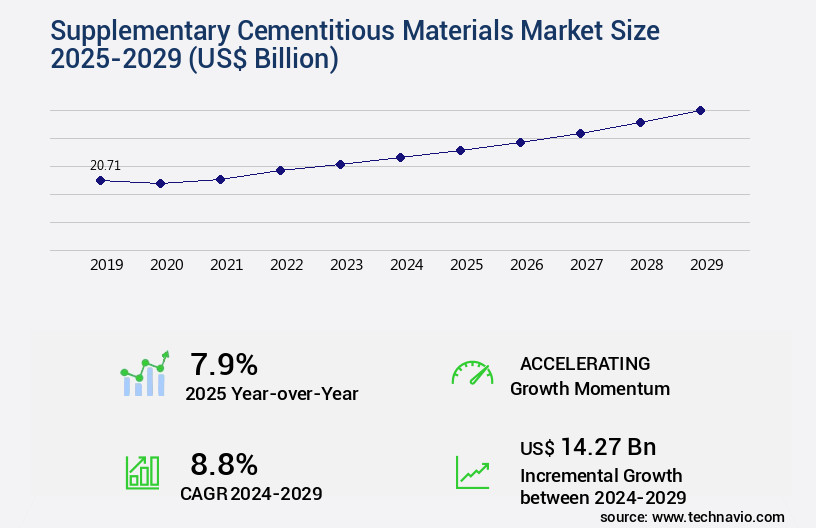
Get Key Insights on Market Forecast (PDF) Request Free Sample
How is the Supplementary Cementitious Materials Market Segmented?
The supplementary cementitious materials industry research report provides comprehensive data (region-wise segment analysis), with forecasts and estimates in "USD billion" for the period 2025-2029, as well as historical data from 2019-2023 for the following segments.
- Type
- Application
- Residential
- Commercial
- Industrial
- Geography
- North America
- Europe
- APAC
- China
- India
- Japan
- South Korea
- South America
- Rest of World (ROW)
By Type Insights
The fly ash segment is estimated to witness significant growth during the forecast period.
The Supplementary Cementitious Materials (SCMs) market is characterized by the continuous exploration of innovative solutions for embodied carbon reduction and waste material utilization. Fly ash, a common SCM, is derived from coal combustion at thermal power stations. It is a rich source of silicon oxide, aluminum oxide, and iron oxide. Despite being a significant environmental concern due to the large volumes generated, its use in cement and concrete production offers substantial clinker reduction potential. The properties of fly ash, such as chloride permeability, heat of hydration, and strength development modeling, are essential in optimizing high-performance concrete mixtures for sustainable concrete production.
The pozzolanic reaction mechanisms of fly ash, including its carbonation resistance and rheological properties analysis, contribute to the development of durable concrete structures. Moreover, the alkaline-aggregate reaction, durability prediction models, and sulfate attack resistance are critical factors in assessing the environmental impact of SCMs. Microstructural characterization, compressive strength testing, and durability performance metrics are crucial in evaluating the effectiveness of SCMs in cement hydration kinetics, workability, and flowability. For instance, calcium sulfoaluminate cement and portland cement blends with fly ash exhibit improved setting time determination and cement replacement levels. Slag cement reactivity and binder optimization strategies further enhance the performance of these blends.
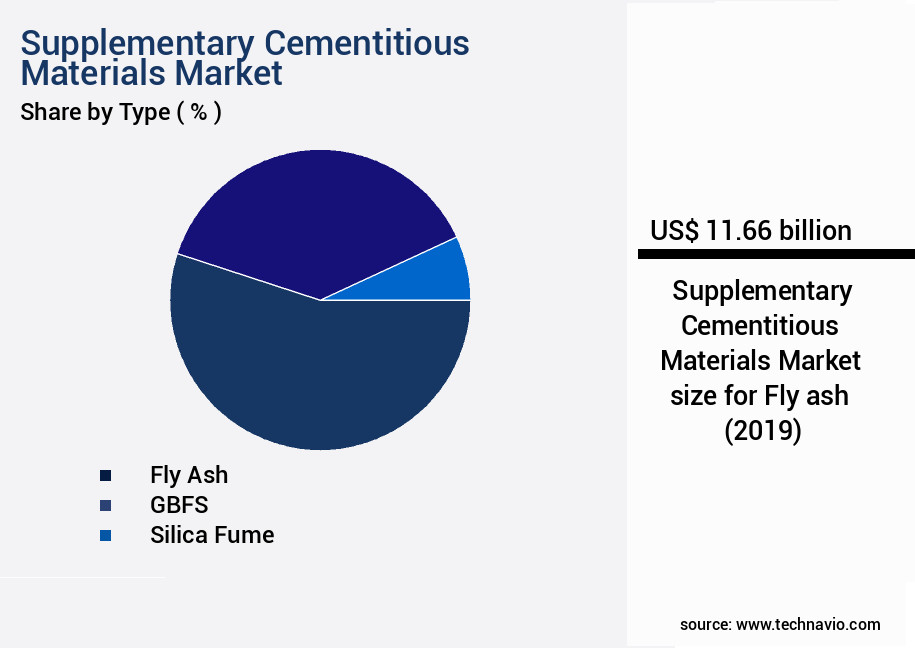
Request Free Sample
The Fly ash segment was valued at USD 11.66 billion in 2019 and showed a gradual increase during the forecast period.
A single ton of fly ash can replace up to 400 kilograms of cement, reducing the carbon footprint of the construction industry by approximately 500 kilograms of CO2 emissions. This underscores the importance of SCMs in the pursuit of sustainable and eco-friendly construction practices.
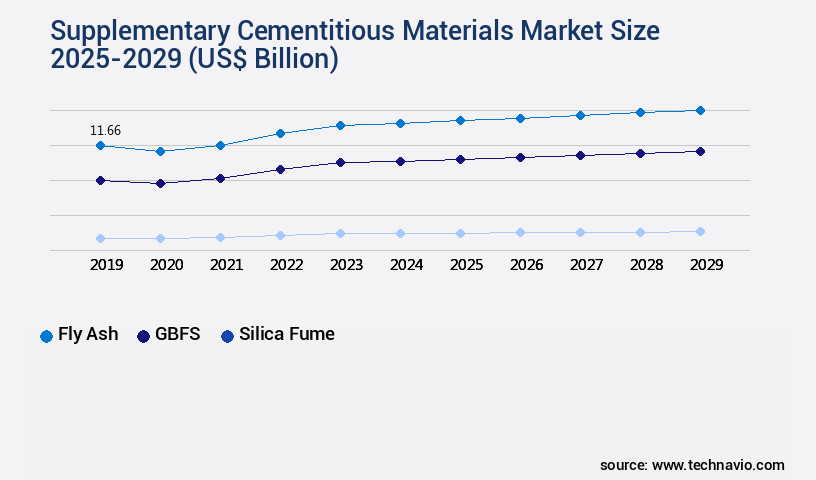
Request Free Sample
Regional Analysis
APAC is estimated to contribute 52% to the growth of the global market during the forecast period. Technavio's analysts have elaborately explained the regional trends and drivers that shape the market during the forecast period.
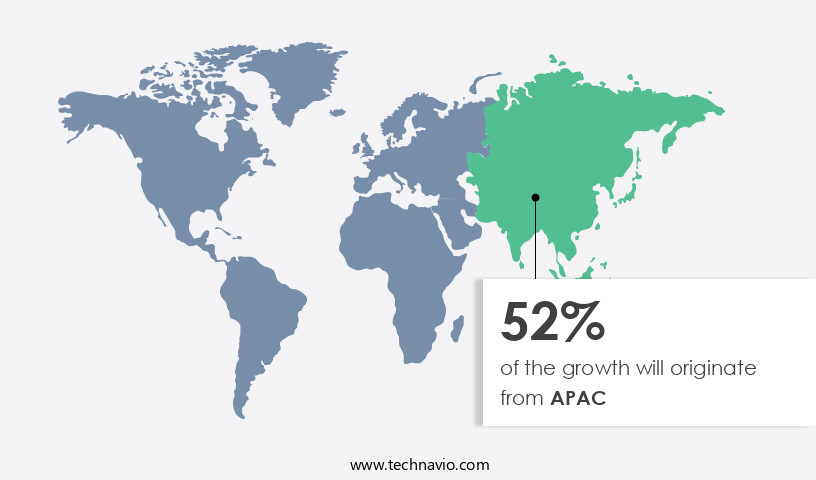
See How Supplementary Cementitious Materials Market Demand is Rising in APAC Request Free Sample
The construction sector in Asia Pacific (APAC) is witnessing substantial growth due to the increasing demand for industrial buildings, warehouses, and infrastructure. Favorable government policies and initiatives, including India's Smart City Mission and Housing for All, are attracting significant investments from both public and private organizations. In response to the rising construction activities in the industrial, commercial, and residential sectors, the adoption of supplementary cementitious materials (SCMs) is surging in APAC. Rapid industrialization is a primary driver of the demand for SCMs in APAC. According to recent studies, the SCMs market in APAC is projected to expand at a remarkable pace, with an estimated growth of over 5% from 2021 to 2028.
Another report suggests that the global SCMs market is expected to reach a value of approximately USD22 billion by 2025, growing at a compound annual growth rate (CAGR) of around 5%. The use of SCMs offers several advantages, such as improved workability, enhanced durability, and reduced carbon footprint, making them an attractive alternative to traditional cementitious materials. The APAC region's construction sector is experiencing a surge, leading to a significant increase in the demand for cost-effective and quick-building solutions.
SCMs, with their numerous benefits, are well-positioned to meet this demand and contribute to the region's ongoing development.
Market Dynamics
Our researchers analyzed the data with 2024 as the base year, along with the key drivers, trends, and challenges. A holistic analysis of drivers will help companies refine their marketing strategies to gain a competitive advantage.
The global supplementary cementitious materials (SCMs) market is experiencing significant growth due to the increasing demand for sustainable and high-performance concrete solutions. SCMs, including fly ash, ground granulated blast-furnace slag, metakaolin, and calcium sulfoaluminate, play a crucial role in enhancing the properties of cementitious materials. Fly ash particle size distribution significantly affects the performance of SCMs in concrete. Optimal particle size distribution ensures improved workability, enhanced compressive strength, and better freeze-thaw resistance. Ground granulated blast-furnace slag's reactivity is another essential factor, as it influences the hydration mechanism of cementitious materials, leading to increased strength and durability. Metakaolin's pozzolanic activity on cement hydration is another critical aspect of SCMs. Its influence on the hydration mechanism results in improved compressive strength, chloride permeability reduction, and sulfate attack resistance enhancement. Calcium sulfoaluminate cement's hydration mechanism is also affected by SCMs, leading to better alkali-aggregate reaction mitigation and carbonation resistance of cement pastes. Binder optimization strategies for durability and sustainability are essential in the cement industry. Cement hydration kinetics modeling techniques and cement replacement levels influence on properties are crucial in achieving high-performance concrete with reduced embodied carbon. Sustainable concrete production methods, such as the use of SCMs, contribute to the reduction of clinker in cement mixtures, thereby decreasing the carbon footprint of the industry. In conclusion, the global SCMs market's growth is driven by the demand for high-performance and sustainable concrete solutions. The influence of SCMs on cement hydration mechanisms, durability prediction models, and binder optimization strategies are essential in ensuring the production of long-lasting, eco-friendly cementitious materials.
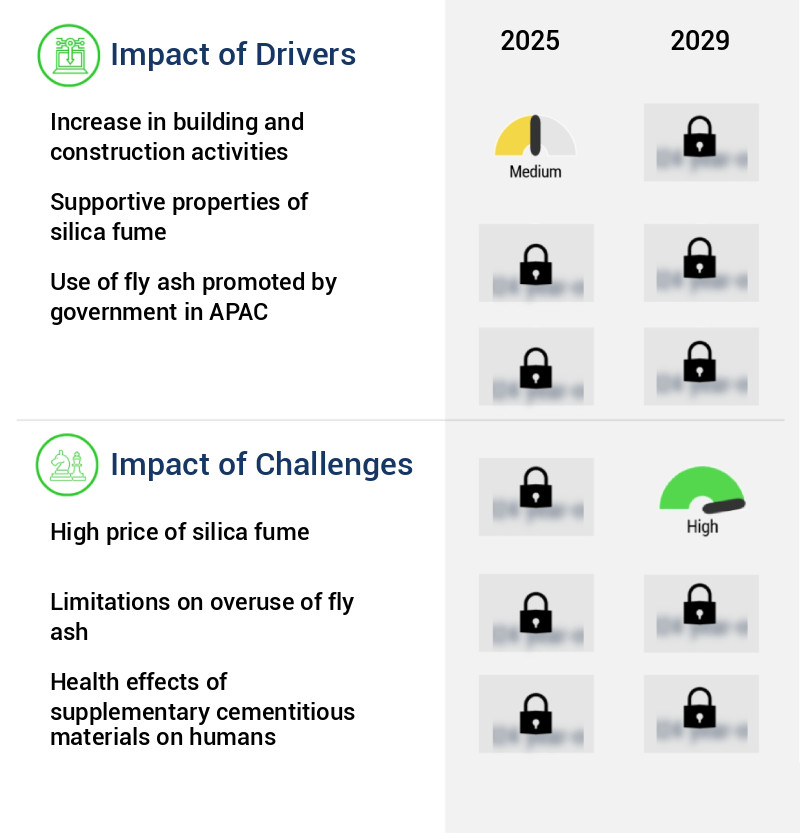
What are the key market drivers leading to the rise in the adoption of Supplementary Cementitious Materials Industry?
- The surge in building and construction activities serves as the primary catalyst for market growth.
- The Supplementary Cementitious Materials (SCMs) market is experiencing significant evolution, driven by the expanding construction industry. SCMs, including fly ash, ferrous slag, and silica fume, contribute to enhanced concrete properties such as improved permeability, increased strength, and cost savings. The global construction sector's growth is projected to be robust, with developing countries like India, China, Malaysia, Brazil, Vietnam, and Indonesia leading the charge.
- These nations are expected to account for over 50% of the global construction market, projected to surpass USD 12 billion by 2027. SCMs' adoption is a strategic response to the increasing demand for sustainable, cost-effective construction solutions.
What are the market trends shaping the Supplementary Cementitious Materials Industry?
- Environment-friendly cement technology is gaining popularity as market trend. This innovative technology prioritizes reducing carbon emissions and minimizing environmental impact in cement production.
- In response to the escalating infrastructure development initiatives by governments worldwide, particularly in the construction sector, the demand for eco-friendly and cost-effective construction materials has become a pressing concern. Supplementary cementitious materials (SCMs), including fly ash, ferrous slag, and silica fume, have significantly influenced cement technology. The construction industry's increasing requirement for bricks and cement underscores the importance of sustainable alternatives to ensure economic interests do not compromise environmental considerations. The utilization of SCMs in construction projects offers numerous benefits, such as reduced carbon emissions, improved workability, and enhanced durability. For instance, the global fly ash market is projected to reach a value of over 14 billion tons by 2025, representing a substantial increase from its current market size.
- Similarly, the ferrous slag market is expected to expand at a steady pace, with an estimated compound annual growth rate of approximately 5%. These trends underscore the evolving nature of the SCMs market and its growing applications across various sectors.
What challenges does the Supplementary Cementitious Materials Industry face during its growth?
- The escalating cost of silica fume poses a significant challenge to the expansion and growth of the industry.
- Silica fume, a key ingredient in the production of concrete for infrastructure projects and construction activities, is increasingly being used as a supplement to Portland cement. The addition of silica fume enhances concrete's properties, including compressive strength, bond strength, and abrasion resistance. The use of silica fume in cement manufacturing results in a cost increase, with prices ranging from USD 400 to USD 1,000 per ton in the US. In contrast, the price of silica fume in India varies between USD 150 and USD 800 per ton due to limited availability.
- This trend underscores the evolving nature of the Supplementary Cementitious Materials (SCMs) market, with silica fume being a significant contributor to its growth. By improving the overall performance of concrete, SCMs, including silica fume, offer long-term cost savings and enhanced durability.
Exclusive Technavio Analysis on Customer Landscape
The supplementary cementitious materials market forecasting report includes the adoption lifecycle of the market, covering from the innovator's stage to the laggard's stage. It focuses on adoption rates in different regions based on penetration. Furthermore, the supplementary cementitious materials market report also includes key purchase criteria and drivers of price sensitivity to help companies evaluate and develop their market growth analysis strategies.
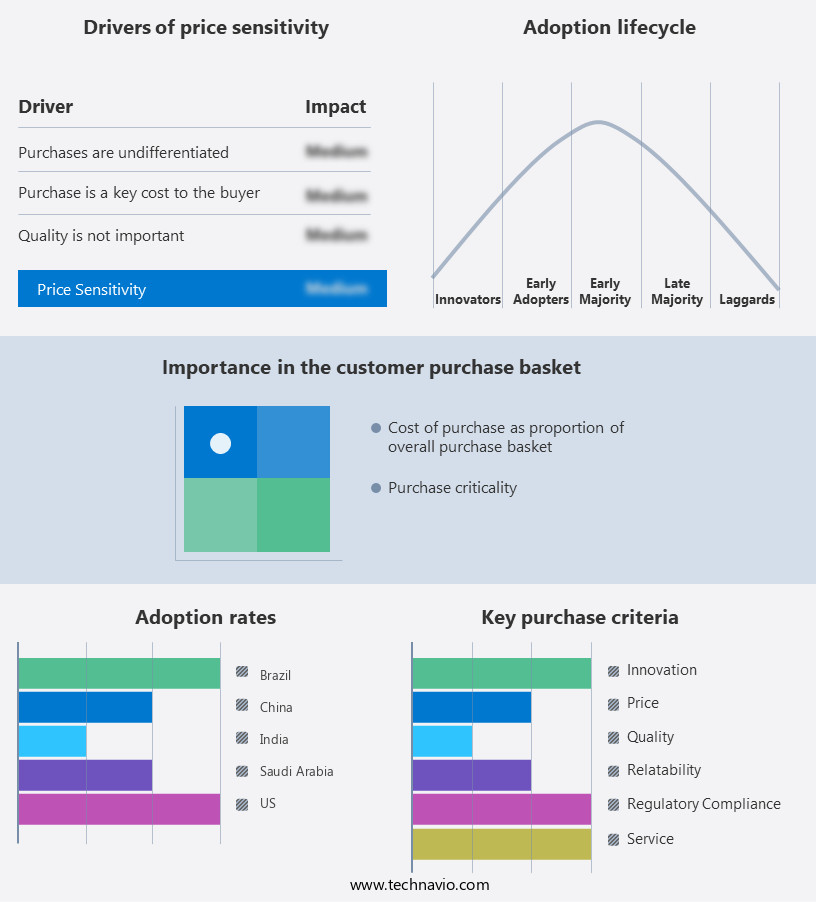
Customer Landscape of Supplementary Cementitious Materials Industry
Competitive Landscape
Companies are implementing various strategies, such as strategic alliances, supplementary cementitious materials market forecast, partnerships, mergers and acquisitions, geographical expansion, and product/service launches, to enhance their presence in the industry.
ArcelorMittal SA - The company specializes in providing advanced cementitious materials, including steel fibers, for large-scale infrastructure projects like the Doha Metro in Qatar.
The industry research and growth report includes detailed analyses of the competitive landscape of the market and information about key companies, including:
- ArcelorMittal SA
- Ashtech India Pvt. Ltd.
- BASF SE
- Boral Ltd.
- Carbon Enterprises Ltd.
- CEMEX SAB de CV
- CR Minerals Co. LLC
- CRH Plc
- Diversified Minerals Inc.
- Elkem ASA
- Ferroglobe Plc
- Heidelberg Materials AG
- Holcim Ltd.
- Kryton International Inc.
- Nippon Steel Corp.
- Shanghai Building Materials Group Co. Ltd.
- Sika AG
- Summit Materials Inc.
- Tata Steel Ltd.
- The Dow Chemical Co.
Qualitative and quantitative analysis of companies has been conducted to help clients understand the wider business environment as well as the strengths and weaknesses of key industry players. Data is qualitatively analyzed to categorize companies as pure play, category-focused, industry-focused, and diversified; it is quantitatively analyzed to categorize companies as dominant, leading, strong, tentative, and weak.
Recent Development and News in Supplementary Cementitious Materials Market
- In January 2024, LafargeHolcim, a leading global building materials company, announced the launch of its new line of sustainable supplementary cementitious materials (SCMs), called "EcoPlanet," at the World of Concrete expo in Las Vegas. These SCMs, derived from industrial by-products and natural minerals, significantly reduce carbon emissions in concrete production (LafargeHolcim press release, 2024).
- In March 2024, HeidelbergCement and Cemex, two major cement producers, entered into a strategic partnership to jointly develop and commercialize new SCM products. This collaboration aimed to enhance their product offerings, improve sustainability, and reduce production costs (HeidelbergCement press release, 2024).
- In May 2024, Sika AG, a specialty chemicals company, completed the acquisition of Cemex's SCM business, including its Fly Ash and Slag business. This acquisition expanded Sika's portfolio in the SCM sector and strengthened its position in the global market (Bloomberg, 2024).
- In February 2025, the European Union passed a new regulation mandating the use of SCMs in cement production to reduce carbon emissions by 30% by 2030. This regulatory push is expected to significantly boost the demand for SCMs in Europe (European Parliament press release, 2025).
Dive into Technavio's robust research methodology, blending expert interviews, extensive data synthesis, and validated models for unparalleled Supplementary Cementitious Materials Market insights. See full methodology.
|
Market Scope
|
|
Report Coverage
|
Details
|
|
Page number
|
208
|
|
Base year
|
2024
|
|
Historic period
|
2019-2023 |
|
Forecast period
|
2025-2029
|
|
Growth momentum & CAGR
|
Accelerate at a CAGR of 8.8%
|
|
Market growth 2025-2029
|
USD 14.27 billion
|
|
Market structure
|
Fragmented
|
|
YoY growth 2024-2025(%)
|
7.9
|
|
Key countries
|
China, US, India, Brazil, Canada, UK, South Korea, Saudi Arabia, Germany, and Japan
|
|
Competitive landscape
|
Leading Companies, Market Positioning of Companies, Competitive Strategies, and Industry Risks
|
Request Free Sample
Research Analyst Overview
- The supplementary cementitious materials (SCMs) market continues to evolve, driven by the growing demand for sustainable concrete production and embodied carbon reduction. SCMs, such as fly ash, slag, metakaolin, and calcium sulfoaluminate cement, offer significant potential for waste material utilization and clinker reduction. For instance, the use of fly ash in concrete mixtures has led to a 30% reduction in clinker consumption, resulting in substantial carbon emissions savings. Moreover, the characterization of raw materials plays a crucial role in optimizing SCM usage and enhancing their properties, such as chloride permeability, heat of hydration, and strength development modeling.
- Furthermore, the ongoing research in the field of SCMs focuses on understanding their rheological properties analysis, alkaline-aggregate reaction, carbonation resistance, and durability prediction models. This continuous exploration is essential for the development of high-performance concrete mixtures, which can offer improved sustainability and performance. According to industry reports, the global SCMs market is expected to grow at a robust rate, with a significant increase in demand for sustainable concrete production. For example, the use of pozzolanic reaction mechanisms, such as metakaolin pozzolanic activity, is gaining popularity due to their potential to enhance the sulfate attack resistance and durability of concrete structures.
- In conclusion, the SCMs market is a dynamic and evolving space, with ongoing research and development activities aimed at optimizing the usage of these materials and enhancing their properties to meet the growing demand for sustainable concrete production. The integration of SCMs in concrete mixtures offers significant potential for waste material utilization, clinker reduction, and embodied carbon reduction, making it a vital area of focus for the construction industry.
What are the Key Data Covered in this Supplementary Cementitious Materials Market Research and Growth Report?
-
What is the expected growth of the Supplementary Cementitious Materials Market between 2025 and 2029?
-
What segmentation does the market report cover?
-
The report is segmented by Type (Fly ash, GBFS, and Silica fume), Application (Residential, Commercial, and Industrial), and Geography (APAC, North America, Europe, South America, and Middle East and Africa)
-
Which regions are analyzed in the report?
-
APAC, North America, Europe, South America, and Middle East and Africa
-
What are the key growth drivers and market challenges?
-
Who are the major players in the Supplementary Cementitious Materials Market?
-
ArcelorMittal SA, Ashtech India Pvt. Ltd., BASF SE, Boral Ltd., Carbon Enterprises Ltd., CEMEX SAB de CV, CR Minerals Co. LLC, CRH Plc, Diversified Minerals Inc., Elkem ASA, Ferroglobe Plc, Heidelberg Materials AG, Holcim Ltd., Kryton International Inc., Nippon Steel Corp., Shanghai Building Materials Group Co. Ltd., Sika AG, Summit Materials Inc., Tata Steel Ltd., and The Dow Chemical Co.
Market Research Insights
- The market is a dynamic and evolving sector within the construction industry. This market encompasses a range of materials used to enhance concrete durability, such as those addressing porosity and permeability, self-healing concrete, and alternative binder systems. For instance, the use of waste-based supplementary materials, like fly ash and slag, has gained significant traction due to their environmental footprint reduction capabilities. According to industry reports, the global market for supplementary cementitious materials is projected to grow by approximately 5% annually. One notable example of market growth comes from the increased adoption of self-healing concrete in infrastructure projects, resulting in substantial sales increases for manufacturers.
- This advanced concrete technology allows structures to repair cracks autonomously, ensuring improved durability and reduced maintenance costs. Moreover, the cement industry is continually seeking ways to optimize OPC-SCM blends and enhance the performance of high-strength concrete designs. This pursuit leads to advancements in material characterization techniques, such as thermal properties analysis and chemical composition analysis, which contribute to the development of sustainable construction materials and green concrete technology.
We can help! Our analysts can customize this supplementary cementitious materials market research report to meet your requirements.
Get in touch
1 Executive Summary
- 1.1 Market overview
- Executive Summary - Chart on Market Overview
- Executive Summary - Data Table on Market Overview
- Executive Summary - Chart on Global Market Characteristics
- Executive Summary - Chart on Market by Geography
- Executive Summary - Chart on Market Segmentation by Type
- Executive Summary - Chart on Market Segmentation by Application
- Executive Summary - Chart on Incremental Growth
- Executive Summary - Data Table on Incremental Growth
- Executive Summary - Chart on Company Market Positioning
2 Technavio Analysis
- 2.1 Analysis of price sensitivity, lifecycle, customer purchase basket, adoption rates, and purchase criteria
- Analysis of price sensitivity, lifecycle, customer purchase basket, adoption rates, and purchase criteria
- 2.2 Criticality of inputs and Factors of differentiation
- Overview on criticality of inputs and factors of differentiation
- 2.3 Factors of disruption
- Overview on factors of disruption
- 2.4 Impact of drivers and challenges
- Impact of drivers and challenges in 2024 and 2029
3 Market Landscape
- 3.1 Market ecosystem
- Parent Market
- Data Table on - Parent Market
- 3.2 Market characteristics
- Market characteristics analysis
4 Market Sizing
- 4.1 Market definition
- Offerings of companies included in the market definition
- 4.2 Market segment analysis
- 4.4 Market outlook: Forecast for 2024-2029
- Chart on Global - Market size and forecast 2024-2029 ($ million)
- Data Table on Global - Market size and forecast 2024-2029 ($ million)
- Chart on Global Market: Year-over-year growth 2024-2029 (%)
- Data Table on Global Market: Year-over-year growth 2024-2029 (%)
5 Historic Market Size
- 5.1 Global Supplementary Cementitious Materials Market 2019 - 2023
- Historic Market Size - Data Table on Global Supplementary Cementitious Materials Market 2019 - 2023 ($ million)
- 5.2 Type segment analysis 2019 - 2023
- Historic Market Size - Type Segment 2019 - 2023 ($ million)
- 5.3 Application segment analysis 2019 - 2023
- Historic Market Size - Application Segment 2019 - 2023 ($ million)
- 5.4 Geography segment analysis 2019 - 2023
- Historic Market Size - Geography Segment 2019 - 2023 ($ million)
- 5.5 Country segment analysis 2019 - 2023
- Historic Market Size - Country Segment 2019 - 2023 ($ million)
6 Qualitative Analysis
- 6.1 The AI impact on global supplementary cementitious materials market
7 Five Forces Analysis
- 7.1 Five forces summary
- Five forces analysis - Comparison between 2024 and 2029
- 7.2 Bargaining power of buyers
- Bargaining power of buyers - Impact of key factors 2024 and 2029
- 7.3 Bargaining power of suppliers
- Bargaining power of suppliers - Impact of key factors in 2024 and 2029
- 7.4 Threat of new entrants
- Threat of new entrants - Impact of key factors in 2024 and 2029
- 7.5 Threat of substitutes
- Threat of substitutes - Impact of key factors in 2024 and 2029
- 7.6 Threat of rivalry
- Threat of rivalry - Impact of key factors in 2024 and 2029
- 7.7 Market condition
- Chart on Market condition - Five forces 2024 and 2029
8 Market Segmentation by Type
- 8.1 Market segments
- Chart on Type - Market share 2024-2029 (%)
- Data Table on Type - Market share 2024-2029 (%)
- 8.2 Comparison by Type
- Chart on Comparison by Type
- Data Table on Comparison by Type
- 8.3 Fly ash - Market size and forecast 2024-2029
- Chart on Fly ash - Market size and forecast 2024-2029 ($ million)
- Data Table on Fly ash - Market size and forecast 2024-2029 ($ million)
- Chart on Fly ash - Year-over-year growth 2024-2029 (%)
- Data Table on Fly ash - Year-over-year growth 2024-2029 (%)
- 8.4 GBFS - Market size and forecast 2024-2029
- Chart on GBFS - Market size and forecast 2024-2029 ($ million)
- Data Table on GBFS - Market size and forecast 2024-2029 ($ million)
- Chart on GBFS - Year-over-year growth 2024-2029 (%)
- Data Table on GBFS - Year-over-year growth 2024-2029 (%)
- 8.5 Silica fume - Market size and forecast 2024-2029
- Chart on Silica fume - Market size and forecast 2024-2029 ($ million)
- Data Table on Silica fume - Market size and forecast 2024-2029 ($ million)
- Chart on Silica fume - Year-over-year growth 2024-2029 (%)
- Data Table on Silica fume - Year-over-year growth 2024-2029 (%)
- 8.6 Market opportunity by Type
- Market opportunity by Type ($ million)
- Data Table on Market opportunity by Type ($ million)
9 Market Segmentation by Application
- 9.1 Market segments
- Chart on Application - Market share 2024-2029 (%)
- Data Table on Application - Market share 2024-2029 (%)
- 9.2 Comparison by Application
- Chart on Comparison by Application
- Data Table on Comparison by Application
- 9.3 Residential - Market size and forecast 2024-2029
- Chart on Residential - Market size and forecast 2024-2029 ($ million)
- Data Table on Residential - Market size and forecast 2024-2029 ($ million)
- Chart on Residential - Year-over-year growth 2024-2029 (%)
- Data Table on Residential - Year-over-year growth 2024-2029 (%)
- 9.4 Commercial - Market size and forecast 2024-2029
- Chart on Commercial - Market size and forecast 2024-2029 ($ million)
- Data Table on Commercial - Market size and forecast 2024-2029 ($ million)
- Chart on Commercial - Year-over-year growth 2024-2029 (%)
- Data Table on Commercial - Year-over-year growth 2024-2029 (%)
- 9.5 Industrial - Market size and forecast 2024-2029
- Chart on Industrial - Market size and forecast 2024-2029 ($ million)
- Data Table on Industrial - Market size and forecast 2024-2029 ($ million)
- Chart on Industrial - Year-over-year growth 2024-2029 (%)
- Data Table on Industrial - Year-over-year growth 2024-2029 (%)
- 9.6 Market opportunity by Application
- Market opportunity by Application ($ million)
- Data Table on Market opportunity by Application ($ million)
10 Customer Landscape
- 10.1 Customer landscape overview
- Analysis of price sensitivity, lifecycle, customer purchase basket, adoption rates, and purchase criteria
11 Geographic Landscape
- 11.1 Geographic segmentation
- Chart on Market share by geography 2024-2029 (%)
- Data Table on Market share by geography 2024-2029 (%)
- 11.2 Geographic comparison
- Chart on Geographic comparison
- Data Table on Geographic comparison
- 11.3 APAC - Market size and forecast 2024-2029
- Chart on APAC - Market size and forecast 2024-2029 ($ million)
- Data Table on APAC - Market size and forecast 2024-2029 ($ million)
- Chart on APAC - Year-over-year growth 2024-2029 (%)
- Data Table on APAC - Year-over-year growth 2024-2029 (%)
- 11.4 North America - Market size and forecast 2024-2029
- Chart on North America - Market size and forecast 2024-2029 ($ million)
- Data Table on North America - Market size and forecast 2024-2029 ($ million)
- Chart on North America - Year-over-year growth 2024-2029 (%)
- Data Table on North America - Year-over-year growth 2024-2029 (%)
- 11.5 Europe - Market size and forecast 2024-2029
- Chart on Europe - Market size and forecast 2024-2029 ($ million)
- Data Table on Europe - Market size and forecast 2024-2029 ($ million)
- Chart on Europe - Year-over-year growth 2024-2029 (%)
- Data Table on Europe - Year-over-year growth 2024-2029 (%)
- 11.6 South America - Market size and forecast 2024-2029
- Chart on South America - Market size and forecast 2024-2029 ($ million)
- Data Table on South America - Market size and forecast 2024-2029 ($ million)
- Chart on South America - Year-over-year growth 2024-2029 (%)
- Data Table on South America - Year-over-year growth 2024-2029 (%)
- 11.7 Middle East and Africa - Market size and forecast 2024-2029
- Chart on Middle East and Africa - Market size and forecast 2024-2029 ($ million)
- Data Table on Middle East and Africa - Market size and forecast 2024-2029 ($ million)
- Chart on Middle East and Africa - Year-over-year growth 2024-2029 (%)
- Data Table on Middle East and Africa - Year-over-year growth 2024-2029 (%)
- 11.8 China - Market size and forecast 2024-2029
- Chart on China - Market size and forecast 2024-2029 ($ million)
- Data Table on China - Market size and forecast 2024-2029 ($ million)
- Chart on China - Year-over-year growth 2024-2029 (%)
- Data Table on China - Year-over-year growth 2024-2029 (%)
- 11.9 US - Market size and forecast 2024-2029
- Chart on US - Market size and forecast 2024-2029 ($ million)
- Data Table on US - Market size and forecast 2024-2029 ($ million)
- Chart on US - Year-over-year growth 2024-2029 (%)
- Data Table on US - Year-over-year growth 2024-2029 (%)
- 11.10 India - Market size and forecast 2024-2029
- Chart on India - Market size and forecast 2024-2029 ($ million)
- Data Table on India - Market size and forecast 2024-2029 ($ million)
- Chart on India - Year-over-year growth 2024-2029 (%)
- Data Table on India - Year-over-year growth 2024-2029 (%)
- 11.11 Brazil - Market size and forecast 2024-2029
- Chart on Brazil - Market size and forecast 2024-2029 ($ million)
- Data Table on Brazil - Market size and forecast 2024-2029 ($ million)
- Chart on Brazil - Year-over-year growth 2024-2029 (%)
- Data Table on Brazil - Year-over-year growth 2024-2029 (%)
- 11.12 Canada - Market size and forecast 2024-2029
- Chart on Canada - Market size and forecast 2024-2029 ($ million)
- Data Table on Canada - Market size and forecast 2024-2029 ($ million)
- Chart on Canada - Year-over-year growth 2024-2029 (%)
- Data Table on Canada - Year-over-year growth 2024-2029 (%)
- 11.13 UK - Market size and forecast 2024-2029
- Chart on UK - Market size and forecast 2024-2029 ($ million)
- Data Table on UK - Market size and forecast 2024-2029 ($ million)
- Chart on UK - Year-over-year growth 2024-2029 (%)
- Data Table on UK - Year-over-year growth 2024-2029 (%)
- 11.14 South Korea - Market size and forecast 2024-2029
- Chart on South Korea - Market size and forecast 2024-2029 ($ million)
- Data Table on South Korea - Market size and forecast 2024-2029 ($ million)
- Chart on South Korea - Year-over-year growth 2024-2029 (%)
- Data Table on South Korea - Year-over-year growth 2024-2029 (%)
- 11.15 Saudi Arabia - Market size and forecast 2024-2029
- Chart on Saudi Arabia - Market size and forecast 2024-2029 ($ million)
- Data Table on Saudi Arabia - Market size and forecast 2024-2029 ($ million)
- Chart on Saudi Arabia - Year-over-year growth 2024-2029 (%)
- Data Table on Saudi Arabia - Year-over-year growth 2024-2029 (%)
- 11.16 Germany - Market size and forecast 2024-2029
- Chart on Germany - Market size and forecast 2024-2029 ($ million)
- Data Table on Germany - Market size and forecast 2024-2029 ($ million)
- Chart on Germany - Year-over-year growth 2024-2029 (%)
- Data Table on Germany - Year-over-year growth 2024-2029 (%)
- 11.17 Japan - Market size and forecast 2024-2029
- Chart on Japan - Market size and forecast 2024-2029 ($ million)
- Data Table on Japan - Market size and forecast 2024-2029 ($ million)
- Chart on Japan - Year-over-year growth 2024-2029 (%)
- Data Table on Japan - Year-over-year growth 2024-2029 (%)
- 11.18 Market opportunity by geography
- Market opportunity by geography ($ million)
- Data Tables on Market opportunity by geography ($ million)
12 Drivers, Challenges, and Opportunity/Restraints
- 12.3 Impact of drivers and challenges
- Impact of drivers and challenges in 2024 and 2029
- 12.4 Market opportunities/restraints
13 Competitive Landscape
- 13.2 Competitive Landscape
- Overview on criticality of inputs and factors of differentiation
- 13.3 Landscape disruption
- Overview on factors of disruption
- 13.4 Industry risks
- Impact of key risks on business
14 Competitive Analysis
- 14.2 Company ranking index
- 14.3 Market positioning of companies
- Matrix on companies position and classification
- 14.4 ArcelorMittal SA
- ArcelorMittal SA - Overview
- ArcelorMittal SA - Business segments
- ArcelorMittal SA - Key news
- ArcelorMittal SA - Key offerings
- ArcelorMittal SA - Segment focus
- SWOT
- 14.5 Ashtech India Pvt. Ltd.
- Ashtech India Pvt. Ltd. - Overview
- Ashtech India Pvt. Ltd. - Product / Service
- Ashtech India Pvt. Ltd. - Key offerings
- SWOT
- 14.6 BASF SE
- BASF SE - Overview
- BASF SE - Business segments
- BASF SE - Key news
- BASF SE - Key offerings
- BASF SE - Segment focus
- SWOT
- 14.7 Boral Ltd.
- Boral Ltd. - Overview
- Boral Ltd. - Business segments
- Boral Ltd. - Key offerings
- Boral Ltd. - Segment focus
- SWOT
- 14.8 Carbon Enterprises Ltd.
- Carbon Enterprises Ltd. - Overview
- Carbon Enterprises Ltd. - Product / Service
- Carbon Enterprises Ltd. - Key offerings
- SWOT
- 14.9 CEMEX SAB de CV
- CEMEX SAB de CV - Overview
- CEMEX SAB de CV - Business segments
- CEMEX SAB de CV - Key news
- CEMEX SAB de CV - Key offerings
- CEMEX SAB de CV - Segment focus
- SWOT
- 14.10 CR Minerals Co. LLC
- CR Minerals Co. LLC - Overview
- CR Minerals Co. LLC - Product / Service
- CR Minerals Co. LLC - Key offerings
- SWOT
- 14.11 CRH Plc
- CRH Plc - Overview
- CRH Plc - Business segments
- CRH Plc - Key news
- CRH Plc - Key offerings
- CRH Plc - Segment focus
- SWOT
- 14.12 Diversified Minerals Inc.
- Diversified Minerals Inc. - Overview
- Diversified Minerals Inc. - Product / Service
- Diversified Minerals Inc. - Key offerings
- SWOT
- 14.13 Ferroglobe Plc
- Ferroglobe Plc - Overview
- Ferroglobe Plc - Business segments
- Ferroglobe Plc - Key news
- Ferroglobe Plc - Key offerings
- Ferroglobe Plc - Segment focus
- SWOT
- 14.14 Holcim Ltd.
- Holcim Ltd. - Overview
- Holcim Ltd. - Business segments
- Holcim Ltd. - Key news
- Holcim Ltd. - Key offerings
- Holcim Ltd. - Segment focus
- SWOT
- 14.15 Sika AG
- Sika AG - Overview
- Sika AG - Business segments
- Sika AG - Key news
- Sika AG - Key offerings
- Sika AG - Segment focus
- SWOT
- 14.16 Summit Materials Inc.
- Summit Materials Inc. - Overview
- Summit Materials Inc. - Business segments
- Summit Materials Inc. - Key news
- Summit Materials Inc. - Key offerings
- Summit Materials Inc. - Segment focus
- SWOT
- 14.17 Tata Steel Ltd.
- Tata Steel Ltd. - Overview
- Tata Steel Ltd. - Business segments
- Tata Steel Ltd. - Key news
- Tata Steel Ltd. - Key offerings
- Tata Steel Ltd. - Segment focus
- SWOT
- 14.18 The Dow Chemical Co.
- The Dow Chemical Co. - Overview
- The Dow Chemical Co. - Business segments
- The Dow Chemical Co. - Key news
- The Dow Chemical Co. - Key offerings
- The Dow Chemical Co. - Segment focus
- SWOT
15 Appendix
- 15.2 Inclusions and exclusions checklist
- Inclusions checklist
- Exclusions checklist
- 15.3 Currency conversion rates for US$
- Currency conversion rates for US$
- 15.4 Research methodology
- 15.7 Validation techniques employed for market sizing
- Validation techniques employed for market sizing
- 15.9 360 degree market analysis
- 360 degree market analysis
- 15.10 List of abbreviations







![]() Get the report (PDF) sent to your email within minutes.
Get the report (PDF) sent to your email within minutes.
Complimentary full Excel data with your report purchase.